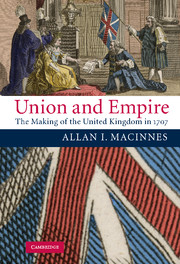Book contents
- Frontmatter
- Contents
- Acknowledgements
- List of abbreviations
- Part I Setting the Scenes
- Part II Varieties of Union, 1603–1707
- Part III The Primacy of Political Economy, 1625–1707
- 6 The transatlantic dimension
- 7 The Scottish question
- 8 Going Dutch?
- Part IV Party Alignments and the Passage of Union
- Part V Conclusion
- Appendix
- Bibliography
- Index
7 - The Scottish question
Published online by Cambridge University Press: 09 July 2009
- Frontmatter
- Contents
- Acknowledgements
- List of abbreviations
- Part I Setting the Scenes
- Part II Varieties of Union, 1603–1707
- Part III The Primacy of Political Economy, 1625–1707
- 6 The transatlantic dimension
- 7 The Scottish question
- 8 Going Dutch?
- Part IV Party Alignments and the Passage of Union
- Part V Conclusion
- Appendix
- Bibliography
- Index
Summary
In addition to the short-lived federative arrangements that were attempted in South Carolina and truncated in East New Jersey during the 1680s, there were effectively three other models for Scottish colonial engagement prior to the Revolution. Firstly, there were the distinctive Scottish commercial networks in New England, the middle colonies, and the tobacco and sugar plantations in the southern colonies and the Caribbean that were sustained as British enterprises. However, these Scottish networks were subject to sustained criticism from the English colonial administration for their clannishness, their diligence in securing positions of influence and their circumventing of the Navigation Acts. Secondly, there were Scottish networks associated with Dutch colonies, albeit mercantilist competition was constricting the close commercial association that Scotland had long enjoyed with the United Provinces. Thirdly, there was the lingering desire that Scotland should pursue a separate colony that would still be under the protection of the common monarchy but no more dependent on England than on Spain, a desire that culminated in the endeavour to colonise Darien on the Panama Isthmus between 1697 and 1700. If the Scots had created an international entrepôt for the Pacific as well as the Atlantic at Darien, there seemed a real prospect that their domestic market would grow to include Ireland and that their entrepreneurial endeavours in the Delaware would lead to the secession of up to three counties to form a Scottish colony of interlopers.
Information
- Type
- Chapter
- Information
- Union and EmpireThe Making of the United Kingdom in 1707, pp. 172 - 200Publisher: Cambridge University PressPrint publication year: 2007
